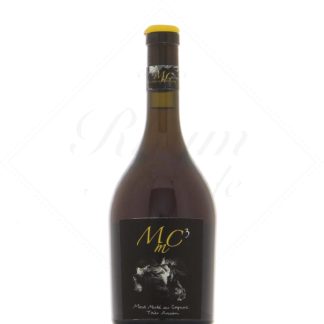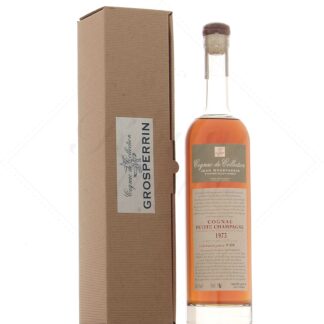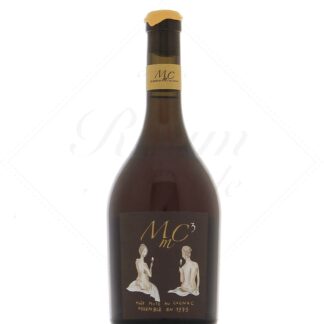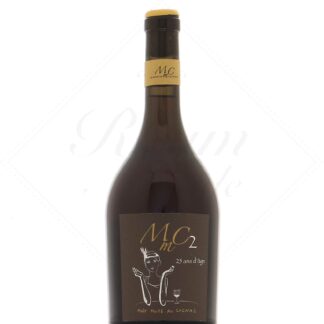Grosperrin

The history of Grosperrin cognac
The origins of Grosperrin cognacs lie with Jean, initially a farm worker and shepherd who also sheared sheep every summer. In 1981, he began distilling fruit in Lorraine, after buying three stills from a distiller. After ten years, Jean sold his stills and moved to Cognac, where he joined boilermaker and distiller Maresté, thanks to the experience he had acquired in Lorraine.
In the 1990s, the main market for cognac was Japan, which was going through a severe financial crisis. It was time to look at his business from a different angle, which he did by becoming an eaux-de-vie broker. He criss-crossed the Charente countryside in search of rare old lots, which he then offered to the region's leading cognac houses.
In 1999, he noticed that the exceptional lots he was unearthing were going into large blends. Upset that these treasures were not being appreciated for their true worth, he bottled the best on his own account. For the first time in the world of cognac, the age of each batch is indicated, and its story told. With his exceptional bottlings, Jean makes the rounds of France's merchants, an effort that ends up being a resounding success.
The passage of generations
In 2003, it was time for Jean Grosperrin to retire, and his son Guilhem took over. At the time, he was one of the only young people in the region to volunteer as an officer in the business. Guilhem Grosperrin continues to pay tribute to the Charente's heritage, without ever distorting it. He takes up his father's broker's notebook, then expands it with new discoveries. Like his father, he hit the road to discover this fabulous land of 4000 distilleries. And like his father, he embarked on a tour of France's merchants, which took him even further afield, to Europe and beyond.
In 2012, Guilhem moved to the current site in Saintes. In 2013, after a few years of drought, cognac enjoyed a revival. That same year, Axelle, Guilhem's sister, joins the family business and represents the brand, notably with the help of her cellar in Saintes. China, Hong Kong, Singapore, Russia - these major markets are once again crazy about French brandies. The American rappers' strange infatuation with cognac, meanwhile, fosters its explosion in the United States, until it spreads all over America.
Grosperrin cognacs
Grosperrin cognacs are renowned for their exceptional bottlings, which are in fact only a small part of their business, the main one being trading. The major cognac houses need Guilhem's expertise to select the old eaux-de-vie that will enhance their blends. The company also works with a number of producers, for special distillations intended for future bottling, or for other merchant clients.
Guilhem continues to select barrels of raw, unreduced eaux-de-vie. In the trade, we speak of eau-de-vie, not cognac. Cognac is a product that has been worked and blended. After selecting and transporting a barrel (or transferring the liquid to a tank), he installs it in one of the company's cellars. Several cellar profiles are available: dry, humid or even very humid. The choice depends on the eau-de-vie, its character, its age, etc.
Work in the winery
Once in the cellar, the eau-de-vie is cask-matured if necessary, with or without reduction, depending on how long it is to be aged, and on its characteristics. The choice of barrel is made according to the same criteria. Coarse-grain oak is preferred for short ageing periods, while fine-grain is intended for longer maturation. Toasting profiles are also important, as is the age of the barrels (new, red, etc.). The wet cellar in Saintes is the last stage before bottling, which is always without addition. The cellar is home to some very old eaux-de-vie. Some are still in barrel, and the oldest are kept in Dame Jeanne.
The different batch numbers actually represent the years of distillation. The range also includes a number of blends, such as VSOP cépages, and the Le Roch range. As for the MMCs (Cognac-mutated musts), they are often very old pineaux from the Charentes region. Collaborations with other bottlers such as Swell de Spirits, Corman Collins and The Auld Alliance can sometimes be seen.
To find out all you need to know about Grosperrin cognacs, read our fascinating articles dedicated to them. Here is the first part of this three-part series, Discovering Grosperrin cognacs. Read less
-
-
-
-
-
Swell de Spirits - Wonders of the World - Cognac 65 Borderies Grosperrin 56,7° C
- Mainland France
- 56.7 ° - 50 cl
-
-
-
-
-
-
-
-
-
-
-















